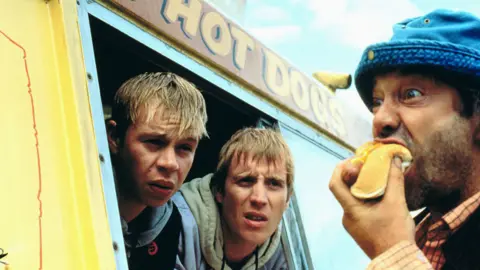Swansea celebrates 50 years of city status
Fifty years ago, the place once dubbed "ugly, lovely town" became the city of Swansea.
On 3 July 1969, Prince Charles stood on the steps of Swansea Guildhall to confirm its new status.
Coming just two days after his investiture as Prince of Wales, the visit was part of a celebratory tour of the nation.
The announcement was the culmination of almost a millennium of Swansea's clamour for recognition.
Cultural historian Prof Peter Stead, who was part of the thousands-strong crowd who gathered to greet the prince, said the proclamation had been a well-kept secret.
"Singleton Park had been opened up to allow people to watch the procession to the Guildhall, but at that stage we didn't know it was anything but a normal royal visit.
"Nowadays there would almost certainly have been a leak on social media or something, but as the news filtered back through the crowd we were dumbstruck, the young prince had really pulled a rabbit out of the hat."
Though perhaps Prof Stead should not have been so surprised.
 AF archive/Alamy Stock Photo
AF archive/Alamy Stock PhotoSwansea first petitioned for a town charter from William de Newburgh, Lord of Gower, in the 12th Century.
This was backed up by a more binding royal charter, granted by King John in 1215.
Swansea began campaigning to be recognised as Wales' first city in the early 19th Century as it grew into the "Copperopolis" which smelted a third of the world's copper, with a larger economic output and greater population than Cardiff at the time.
However, the first unsuccessful bid for city status did not come until 1911, by which time metallurgy in Swansea was already in decline and coal had made Cardiff king.
It would take another 58 years for Swansea to achieve its goal - city status finally being granted in recognition of efforts to regenerate after the devastation of the Three Day Blitz.
But Prof Stead believes Swansea has not always taken full advantage of its city status.
"I think sometimes we take the 'ugly lovely town' epithet a bit too far," he said.
"Swansea people don't take themselves too seriously and over the years we've played up to the second city, Cardiff's scruffy younger brother image.
"That makes Swansea a charming and relaxing place to live, but it does mean we haven't pushed our natural advantages - our environment, culture and universities - nearly hard enough.
"That's something we're going to have to take far more seriously in the next 50 years."

These are sentiments echoed by Swansea council leader Rob Stewart, who argues making a success of the £1.3bn Swansea Bay City Deal may be their only chance at securing the city's future.
"We've already started a major regeneration as part of the city deal, with a £129m arena, retail and leisure development around the city centre and Oystermouth Road - that's not planned work, this is work which is already on-site.
"But if the city deal is going to be successful, it can only be a kick-start for private investment, which is why we've issued a £750m call to arms for investors to share in the city's transformation and prosperity."
He said the UK government's decisions not to go ahead with electrification of the south Wales mainline and to shelve the proposed tidal lagoon hampered regeneration attempts, but must not be an excuse.
"Of course I'm disappointed, but our job now is to concentrate on what we can do, by creating an integrated metro system using unused railway capacity linked intelligently with buses and other public transport.
"If we succeed with that, in the next 50 years we can look forward to a positive future, based around a green economy, technology and tourism."
Swansea is marking its birthday with Prince Charles - along with The Duchess of Cornwall - back in Swansea for the occasion.
It is part of a year of events culminating on 15 December, the day Swansea formally received its letters patent from the Queen.
A weekend of street parties across the city kicked off on Thursday when St Helen's Road closed for five hours to celebrate its reputation as Swansea's most diverse street.

People from 22 ethnic backgrounds shared Tai Chi from the Chinese community, music from the Aber Taiko drummers, food from the street's vast range of Asian restaurants, a papier mache Indian elephant, a world music stage and open day at the neighbourhood mosque.
The party formed the background for the video of the official Swansea at 50 anthem - This Is Our City - written by Michael Mullan and performed by 12-year-old Justine Afante.
Mr Mullan said he was looking forward to it being performed in front of the Prince of Wales.
"It would be great to speak to him and let him know what a wonderful city full of wonderful people we live in.
"When the video comes out, we want everyone to share it and make sure everyone around the world knows what an amazing city we live in."
Another musical offering comes from singer and broadcaster Mal Pope, with the opening of his Calon Lan The Musical, at Swansea's Grand Theatre on Wednesday night.
Next season's Swansea City football kit will carry a commemorative 1969 logo to mark the occasion.
